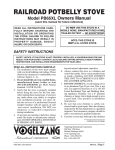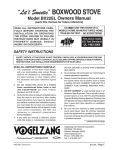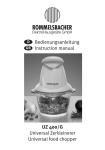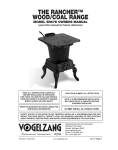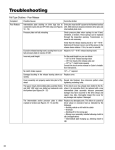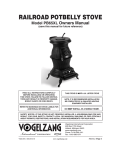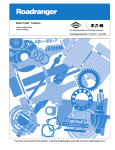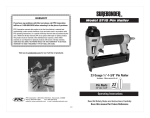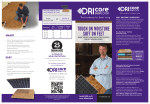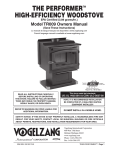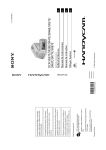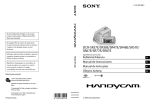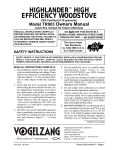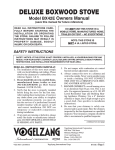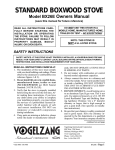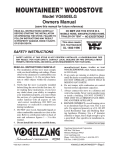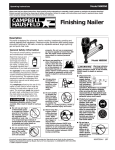Download Vogelzang International SR57E User's Manual
Transcript
THE Rancher™ Wood/Coal Range Model SR57E Owners Manual Save this manual for future reference! READ ALL INSTRUCTIONS CAREFULLY BEFORE STARTING THE INSTALLATION OR OPERATING THE STOVE. Failure to follow instructions may result in property da m age , bodily injury, or even death. Do NOT use this stove in a mobile home, Manufactured Home, Tent or trailer. (NO EXCEPTIONS) NOTE: This stove is NOT a UL listed stove. SAFETY INSTRUCTIONS Safety Notice: If this stove is not properly installed, a house/building fire may result. For your safety, contact local building or fire officials about permits, restrictions, and installation requirements for your area. Read All Instructions carefully. 1. The installation of this stove must comply with your local building code rulings. Please observe the clearances to combustibles (see reference figures 1 & 2). 2. Do not install this stove in a mobile home or trailer (NO EXCEPTIONS). 3. Always connect this stove to a chimney and vent to the outside. Never vent to another room or inside a building. 4. Do NOT connect a wood burning stove to an aluminum Type B gas vent. This is not safe. Use approved masonry or a UL 103 HT Listed Residential Type and Building Heating Appliance Chimney. Use a 6” diameter chimney or larger, that is high enough to give a good draft (see specifics in installation instructions.) 5. Be sure that your chimney is safely constructed and in good repair. Have the chimney inspected by the fire department 6. 7. 8. 9. or a qualified inspector. Your insurance company may be able to recommend a qualified inspector. Creosote or soot may build up in the chimney connector and chimney and cause a house/ building fire. Inspect the chimney connector and chimney twice monthly during the heating season and clean if necessary (see Maintenance & Service Hints, page 9.) To prevent injury, do not allow anyone to use this stove who is unfamiliar with the correct operation of the stove. Do not operate stove while under the influence of drugs or alcohol. For further information on using your stove safely, obtain a copy of the National Fire Protection Association (NFPA) publication, “Using Coal and Wood Stoves Safely” NFPA No. HS-10-1978. The address of the NFPA is Battery March Park, Quincy, MA 02269. continued on page 2 Vogelzang International Corporation 400 West 17th Street Holland, Michigan 49423 www.vogelzang.com Phone: 1-616-396-1911 Fax: 1-616-396-1971 VGZ-004 / 20110524.0 SR57E / Page 1 SAFETY INSTRUCTIONS continued… 10.The paint used on your stove may give off smoke and/or odor during the first fires. This may occur during the first 12 to 15 fires until the paint has cured. After the paint has cured this will end and not reoccur. Persons with lung conditions or owners of susceptible domestic pets (such as birds) should take prudent precautions. Open windows and doors as needed to clear smoke and odor. If the stove is overfired, paint discoloration will occur. 11.This stove has a painted surface which is durable but it will not stand rough handling or abuse. When installing your stove, use care in handling. Clean with soap and warm water when stove is not hot. Do not use any acids or scouring soap, as these solvents wear and dull the finish. 12.While stove is in operation, all persons, especially young children should be alerted to the hazards from high surface temperatures. Keep away from a hot stove to avoid burns or clothing ignition. During operation, small children should be carefully supervised when they are in the same room as the stove. 13.Keep stove area clear and free from all combustible materials, gasoline, and other flammable vapors and liquids. 14.Ashes should not be allowed to accumulate higher than the side of the ash pan. Dispose of ashes in a metal container with a tight fitting lid. Other waste shall not be placed in this container. Keep the closed container on a noncombustible floor or on the ground, well away from all combustible materials. Keep the ashes in the closed container until all cinders have thoroughly cooled. The ashes may be buried in the ground or picked up by a refuse collector. 15.To prevent burns, always wear protective clothing, leather hearth gloves and eye protection, while tending the fire. 16.While in operation, keep the feed door closed at all times except while tending the fire. 17.Do not over fire the stove. Over firing will occur if the feed door is left open during operation. Such actions will result in very dangerous operating conditions. NOTE: A professional, licensed heating and cooling contractor should be consulted if you have questions regarding the installation of this solid fuel burning appliance. Assembly Instructions tools required Safety Glasses Hearth Gloves Pencil 6 foot Folding Rule or Tape Measure Tin Snips Drill: Hand or Electric 1/8” dia. Drill Bit (sheet metal screws) Screwdrivers (blade and phillips types) 13mm Nut Driver or Ratchet with 13mm Socket (for 13mm Hex Nuts) 13mm Nut Driver or Ratchet with 13mm Socket (for Stove Bolts) CAUTION: Stove is heavy. Make sure you have adequate help and use proper lifting techniques whenever moving stove. Refer to diagram and parts lists at back of this manual. 1. Uncrate the stove and remove cardboard packing and protective poly bag. (Save cardboard for further assembly.) 2. Remove parts from inside of stove. Parts include: four lids (#1), three lid supports (#4 & #5), one ash door (#14), one lid lifter (#16), four legs (#15), hardware pack (#17), and Page 2 / SR57E materials required (NOTE: The following items are NOT included with your stove) Flooring Protection: 56” x 59” Chimney: Existing 6” Lined Maas specified (see page 3) sonry Chimney or 6” Inside Dia. Chimney Connection: 6” black listed Type HT chimney. steel (24 ga. min.) straight or Furnace Cement (manufacturer elbow (as required) recommends Rutland Code 78 or equivalent) 1/2” Sheet Metal Screws Spring Handle (#12) and draft damper (#18). 3. Place flattened carton on floor and carefully turn stove over onto carton. 4. Attach the legs to base of stove with stove bolts. 5. Carefully lift stove upright and place in desired location (see following instructions for properly locating stove). 6. Place lid supports and four lids in position on stove top. 7. Lower ash door into position. 8. Install draft damper into stove pipe. VGZ-004 / 20110524.0 D-6 Draft Damper A Draft Damper included with the stove must be installed in the first straight section of pipe exiting the stove before the stove pipe is connected and the cook stove is used. 1. Drill two 1/4” holes centered on either side of the pipe section 6” from the top end of the pipe (figure 6). 2. Remove the handle from the damper then slide the damper into the pipe. 3. Align the damper with the holes drilled in step 1 and insert the handle through the holes and the damper. NOTE: This damper is necessary for the proper operation of the stove and to meet EPA emissions requirements for heating appliances. It MUST be installed before use. (NO EXCEPTIONS) Draft Damper (must be installed before use — NO EXCEPTIONS!) 6"/15.25 cm Fig. 1 Draft Damper Installation Locating Stove Proper clearances must be maintained for adequate air circulation. Adequate ventilation must be provided while operating this stove. 1. The stove must be placed on solid concrete, solid masonry, or when installed on a combustible floor, on a Underwriters Laboratory Listed floor protector, such as Hy-C or Imperial Model UL 5659. The base must extend at least 18” beyond the front of the hearth, 18” to the sides of the stove, and must extend under the stove pipe if it is elbowed towards a wall (see figure 2 and consult local building codes and fire protection ordinances.) DASHED LINE SHOWS HORIZONTAL CHIMNEY CONNECTOR AND ADDITIONAL FLOOR PROTECTION REQUIRED FLOOR PROTECTOR SIDEWALL Continued on page 4 BACKWALL 36" 18" 2. The stove must have its own flue. Do not connect this unit to a chimney flue serving other appliances. 3. After observing the clearances to combustible materials (figure 2 & 3), locate your floor protector accordingly (figure 2) and carefully place the stove in your selected location. Install stove pipe, elbows, and thimble as required, utilizing either a recently cleaned and inspected 6” masonry chimney or a 6” i.d. listed chimney. Maximum 64 square inches. COMBUSTIBLE CONSTRUCTION ACCORDING TO NFPA 211 59" COMBUSTIBLE CONSTRUCTION ACCORDING TO NFPA 211 36" 18" 18" 56" (TOP VIEW) Fig. 2 – Minimum Clearance Dimensions from Combustible Surfaces VGZ-004 / 20110524.0 SR57E / Page 3 Locating Stove continued… CORNER CLEARANCES 36" 36" Fig. 3 – Top View Minimum Corner Clearances from Combustible Surfaces 4. Use 6” round black stove pipe, not galvanized stove pipe. Secure pipe sections with three (3) sheet metal screws in each stove pipe and/ or elbow joint to firmly hold the pipe sections together. Do Not connect this stove to any air distribution or duct system. 5. R e c h e c k c l e a r a n c e s f r o m t h e s t o v e , connector stove pipe, and corner clearances using the illustrations (figure 1 & 2) and Minimum Clearances To Combustible Surfaces Unit to Sidewall........................ 36 inches Unit to Backwall....................... 36 inches Unit Corner to Wall................... 36 inches Pipe Connector to Ceiling....... 18 inches CAUTION: Keep furnishings and other combustible materials away from the stove. your local building codes or fire protection ordinances. NOTE: Drywall faced with brick or stone should be considered a combustible surface. 6. D o N ot install this stove in a m obile ho m e or trailer . (NO EXCEPTIONS) 7. T h e c l e a r a n c e s p r ov i d e d a r e m i n i m u m dimensions. Installation of this stove must comply with your local building code rulings. 8. This stove is NOT a UL listed stove. Pipe Installation 1. The smooth end of the stovepipe fits over the cast 6. It is recommended that no more than two (2) iron collar. To attach, simply hand form the smooth 90° bends be used in the stovepipe installaend of the round stove pipe into an oval shape (fig. tion. The use of more than two 90° bends may 4). Drill & secure with a minimum of three (3) sheet decrease the amount of draw and possibly metal screws. cause smoke spillage. Where possible, use only cor rugated (nonadjustable) elbows. These 2. Horizontal pipe runs must slope upwards provide a better seal. towards the chimney at least 1/4” per foot of horizontal run. 7. The chimney connector must not pass through an attic or roof space, closet, or any concealed space, or 3. You must have at least 18 inches of clearance befloor, ceiling, wall or combustible construction. tween any horizontal piping and the ceiling. 4. The pipe cannot extend into the chimney flue (figure 5). NOTE: Stove pipe is NOT INCLUDED. 5. Secure pipe/elbow sections with three (3) sheet TO PURCHASE PIPE, Visit your local metal screws at each joint to make the piping hardware, HOME or building center. See “Locating Stove” page 3 for rigid. additional specifications. CORRECT Fig. 4 – Hand-form pipe to fit stove collar Page 4 / SR57E WRONG WRONG Fig. 5 – Stovepipe/Flue Connections VGZ-004 / 20110524.0 Chimney connections Chimneys perform two functions. 1). As a means of exhausting smoke and flue gases which are the result of fuel combustion. 2). The chimney provides “draft” which allows oxygen to be continuously introduced into the appliance, so that proper combustion is possible. As of April 1, 1987 all wood stoves should be installed using a factory built chimney that meets the “Type HT” requirement of UL 103 (when using a factory built chimney). Note, your stove does not create draft. Draft is a function of the chimney. A minimum of 0.05 w.c., (measured in water column) is required for proper drafting to prevent back-puffing, smoke spillage, and to maximize performance. (Gauges to measure chimney draft are readily available at stove shops and are economical to purchase or rent.) IMPORTANT Installation Points 1. Size the chimney flue to the stove pipe. (6” pipe = 6” chimney flue. Max. 64 sq. inches) 2. Use elbows only as necessary. Elbows reduce draft, no more than two should be used in any chimney run. 3. Make sure all horizontal runs of connector pipe have a minimum outward rise of 1/4” per horizontal foot. This allows any condensation or creosote buildup to run back into the firebox. Masonry Chimney Before using an existing masonry chimney, clean the chimney, inspect the flue liner and make any repairs needed to be sure it is safe to use. Make repairs before attaching the stove. The connector stove pipe and fittings you will need to connect directly to a masonry chimney are shown in figure 6. If the connector stove pipe must go through a combustible wall before entering the masonry chimney, consult a qualified mason or chimney dealer. The installation must conform to local building and fire codes and latest edition of NFPA 211. Do not connect this stove into the same chimney flue as the fireplace, gas appliance, or a flue connected with any other stove. The chimney used for a stove must not be used to ventilate the cellar or basement. If there is a cleanout opening in the base of the chimney, close it tightly. VGZ-004 / 20110524.0 THIMBLE 6˝ ROUND 24 ga. BLACK CONNECTOR STOVEPIPE COLLAR CHIMNEY FLUE 5/8" TILE CHIMNEY LINER 8˝ MIN. LINER BELOW ENTRY HOLE MASONRY CHIMNEY Fig. 6 - Masonry Chimney Connection Listed Chimney Carefully follow chimney manufacturer’s instructions. Use only a listed chimney. If your chimney starts at the ceiling (figures 7 & 8) you will need enough 6” round black stove pipe to reach the ceiling. The top of the chimney must be at least three (3) feet above the roof and be at least two (2) feet higher than any point of the roof within ten (10) feet (figure 7 – 9). Fig. 7 - Chimney Construction Through Attic Space SR57E / Page 5 Chimney connections continued … Fig. 8 - Chimney Construction Through Roof Venting to Existing Fireplace In some instances, people desire to convert an existing fireplace for stove use. Usually, safe connection to an existing masonry chimney requires more work than using a prefabricated chimney. The existing fireplace must be closed and sealed at the damper with high-temperature caulk, ceramic wool, or furnace cement. Prior to installation, clean and inspect the existing flue and smoke shelf. Installation should be designed so the system can be dismantled for periodic cleaning and inspection. Before conversion, make sure the existing chimney is structurally sound, the chimney incorporates a flue liner and make sure it is in good condition. (A flue liner consists of clay tile that protects the brickwork of a chimney. If a chimney does not have a liner, or it is damaged, have it relined by a professional. Do Not use a chimney that is unlined or damaged!) If you have any question regarding the condition of the chimney, consult a qualified licensed contractor, qualified engineer, competent mason, certified Chimney Sweep, or a knowledgable inspector. Consult your insurance company if you cannot find a qualified expert. CAUTION: Not all fireplaces are suitable for conversion to a wood stove. Check with a qualified expert. Fig. 9 - Chimney Connection to Firebox Through Masonry Wall Page 6 / SR57E Many prefabricated fireplaces are of the “zeroclearance fireplace” category. These consist of multilayered metal construction. They are designed with enough insulation and/or air cooling on the base, back and sides so they can be safely installed in direct contact with combustible floors and walls. Although many prefabricated fireplaces carry endorsements from nationally recognized organizations for use as fireplaces, they have not been tested for connection to wood stove heaters. Connecting a stove to such a device will void the manufacturer’s warranty. Steel-lined fireplaces are constructed with 1/4” firebox liner, an air chamber in connection with 8” of masonry. These can be safely used with wood burning stoves. They contain all the essential components of a fireplace, firebox, damper, throat, smoke shelf, and smoke chamber. Many look identical to masonry fireplaces and VGZ-004 / 20110524.0 Chimney connections continued … should be checked carefully before connecting a 2. Install a metal or fire clay (5/8” minimum thickness) thimble. Make sure the thimble is flush stove to them. with the inner surface of the chimney liner and Venting a stove directly into a fireplace does does not protrude into the flue (see figure 5 on not meet code and should not be attempted. (This page 4). constitutes connection to another appliance - the fireplace.) Combustion products will be deposited 3. Secure the thimble with refractory mortar. The thimble should be surrounded by 8” of solid and build up in the firebox or fireplace. The stove unit masonry brickwork or 24” of stone. warranty will be void with such an installation. Do 4. Install the stovepipe into the thimble as far as not create a hazard in your home by connecting in possible without extending past the flue lining this manner. (see figures 5 & 6 on pages 4 & 5). 5. A small airspace (about 1/2”) should remain Fireplace Installation between the stovepipe and thimble to allow for Directly connecting the stovepipe into the expansion of the pipe. Seal this airspace with existing masonry chimney (figure 10 “Type A” high-temperature caulking or ceramic wool. fireplace conversion) of the fireplace is the only 6. Secure and seal the damper in the closed position using high-temp caulking, ceramic approved method of installation. This is a wool, or furnace cement. Also check to see if complicated and involved process and to insure the chimney has a cleanout. If it does, make safety should only by done by a qualified insure it is closed and sealed as well. A leaky staller. cleanout will greatly reduce draft efficiency. 1. An entry hole must be cut through the masonry and tile liner with minimal damage to the liner. At least 8” of liner must remain below the If you have any questions regarding venting entry position. When locating the stove and your stove, contact the manufacturer or contact stovepipe, all minimum clearances must be the National Fire Protection Association (NFPA) observed from combustible surfaces includ- and request a copy of the latest editions of NFPA ing mantels, combustible trimwork, ceilings Standard 211 and NFPA Standard 908. Their adand walls. Positioning the center of the stove pipe entry into the chimney 24” below the dress is: Battery March Park, Quincy, MA 02269. ceiling should insure proper clearance for a 6” stovepipe. NOTICE: SEE CHIMNEY CONNECTORS & CLEARANCES ON PAGE 11 FOR PASSTHROUGH CLEARANCES TO COMBUSTIBLE WALL AND ROOFING MATERIALS. Fig. 10 - Fireplace Conversion VGZ-004 / 20110524.0 SR57E / Page 7 Operating Instructions CAUTION: HOUSE FIRE HAZARDS • H ot w h i l e i n o p e r at i o n . K e e p Children, clothing and furniture away. Contact may cause skin burns. • Do not store wood or coal on floor protector, underneath stovepipe or anywhere within minimum clearances from combustible surfaces specified for this stove. (36”) • Overfiring may cause a house fire. you are overfiring If the stove or chimney connector glows red. WARNING: Explosion Hazard • Never use chemicals, gasoline, gasoline-type lantern fuel, kerosene, charcoal lighter fluid, or similar flammable liquids to start or “freshen-up” a fire in the stove. • Keep all flammable liquids, especially gasoline, out of the vicinity of the stove — whether in use or in storage. Operating Safety Precautions 1. Never overfire this stove by building excessively hot fires as a house/ building fire may result. you are overfiring the stove If stove or stovepipe begins to glow or turn red. 2. Never build extremely large fires in this type of stove as damage to the stove or smoke leakage may result. 3. Stove is HOT while in operation. Keep children, clothing, and Furniture away from hot stove. Contact may cause skin burns. Do not touch the stove after firing until it has cooled. 4. Provide air into the room for proper combustion. 5. Inspect stovepipe every 60 days. Replace immediately if stovepipe is rusting or leaking smoke into the room. This stove is designed to burn WOOD OR COAL. Hardwood, 10” to 14” should be split and air dried (seasoned), for 6 months to obtain maximum burning efficiency. Wood should be stored in a dry, well ventilated area. NOTICE: Use solid Fuel materials only. Do Not burn garbage or flammable fluids. NOTE: For best results us when burning coal, use solid, bituminous coal. NEVER use manufactured coal “bricks” made of coal dust and wax-type binder. Do not burn garbage or flammable solids. Store coal in dry, well ventilated area. Lighting 1. Open draft damper fully to provide maximum draft. 2. Remove lid(s) and place several wads of crushed paper in the firebox. 3. Lay small stacks of kindling on the paper to start the fire. 4. Light the paper and kindling and replace the lid(s). Make sure they are seated properly. Keep ash door closed when stove is in use. 5. Add fuel after fire is burning briskly. Use care not to smother the kindling fire when adding fuel. Replace the lid(s) and make sure they are seated firmly. 6. Adjust the draft damper and spin draft control. The more closed the spin draft is set, the lower and slower the fire will burn. The more open, the faster and hotter the fire will burn. Do not overfire the stove. Adding Fuel Add small amounts of fuel each hour or so instead of piling large quantities of fuel at one time. This will insure a more complete combustion process and less buildup of tars, soot, or creosote will occur in the chimney. 1. Always open draft damper before adding fuel. 2. Always wear protective hearth gloves when adding fuel. 3. Be careful not to smother the fire when adding fuel . Continued on next page Page 8 / SR57E VGZ-004 / 20110524.0 Operating Instructions continued … 4. Make sure lid(s) is(are) replaced and fully seated. 5. Adjust the damper and slide draft control. 6. Empty ashes regularly. Do not allow ashes to pile up higher than the top of the hearth (see Safety Instructions #14 page 2). If ashes build up to the grate, burnout will occur. 7. Properly dispose of hot ashes (see Safety Instructions, item #14 on page 2.) 8. Do not over fire the stove. CAUTION: DO NOT OVER FIRE appliance. Too much wood or burning non-recommended materials such as trash or flammable liquids may cause over firing. You are over firing if the chimney connectors or stove glows red. Close the ash door, spin draft and damper immediately to reduce the air supply to the fire. This will slow down the fire. CAUTION: Slow burning fires and extended use may cause excessive creosote buildup. Ignition of creosote buildup or over firing may cause a chimney fire. Chimney fires burn extremely hot and may ignite surrounding materials. In case of a chimney fire call the fire department immediately. Maintenance & Service Hints ASH DISPOSAL – Do not allow ashes to accumulate higher than the grate. Dispose of properly. (See Safety Instructions #10, page 2.) Chimney Draft – Draft is a function of the chimney, not the stove — do not expect the stove to draw. Smoke spillage into the house or excessive buildup of condensation or creosote in the chimney are warnings that the chimney is NOT functioning properly. Correct the problem before using the stove. Following are some possible causes for improper draft. 1. The connector stovepipe may be pushed into the chimney too far, stopping the draft. 2. If the chimney temperature is too cool, water will condense in the chimney and run back into the stove. Creosote formation will be rapid and may block the chimney. Operate the stove at a fire level high enough to keep the chimney warm to prevent condensation from forming. 3. If the fire burns well but sometimes creates excess smoke or burns slowly, it may be caused by the chimney top being lower than another part of the house or a nearby tree. The wind blowing over a house or tree, falls on top of the chimney like water over a dam, beating down the smoke. The top of the chimney should be at least three (3) feet above the roof and be at least two (2) feet higher than any point of the roof within ten (10) feet. CREOSOTE – Formation and Removal. Slow-burning wood produces tar and other organic VGZ-004 / 20110524.0 vapors which combine with expelled moisture to form creosote. Creosote vapors condense in the relatively cool chimney flue of a slow-burning fire. As a result, creosote residue accumulates on the flue lining. If ignited, this creosote creates an extremely hot fire which may ignite surrounding materials resulting in a building fire. If creosote has accumulated, it should be removed. Failure to remove creosote may result in ignition and may cause a house/building fire. Creosote may be removed using a chimney brush or other commonly available materials from your local hardware retailer. Chimney Inspections – The chimney connector and chimney should be inspected at the beginning of and at least twice a month during the heating season to determine if a creosote buildup has occurred. Chimney fires burn very hot. If the chimney connector should glow red, reduce the fire by closing the damper and spin draft control and immediately call the fire department. CAUTION: A chimney fire may cause ignition of wall studs or rafters which were assumed to be a safe distance from the chimney. If a chimney fire has occurred, have your chimney inspected by a qualified expert before using again. Continued on next page SR57E / Page 9 Maintenance & Service continued … A fire in the stove may be smothered by pouring a large quantity of coarse salt, baking soda, or cool ashes on top of the fire. Stove Joints – Required Tune-up. This stove is manufactured with cast iron components. It does not have welded seams. Periodic “tune up” may be required by refilling and/or replacing the cement/joint mortar along the seams where the cast iron components meet. Ordering Parts SR57E Rancher™ Wood/coal Range When ordering missing or replacement parts, always give the Model Number of the stove, Part Number, and Part Description. Use the illustration and parts list provided to identify parts. art No. P 1 2 3 4 5 6 7 8 9 10 11 12 13 14 15 16 17 18 DescriptionQty. Cook Lid....................................................... 4 Collar Top...................................................... 1 Top Plate....................................................... 1 Removable Plate.......................................... 2 Lid Support................................................... 1 Burn Chamber.............................................. 1 Lower Chamber............................................ 1 Shaker Door ................................................ 1 Base............................................................. 1 Ash Door....................................................... 1 Spin Draft...................................................... 1 Spring Handle............................................... 1 Grate . .......................................................... 1 Ash Pan........................................................ 1 Legs . ........................................................... 4 Lid Lifter........................................................ 1 Hardware Pack ............................................ 1 Draft Damper ............................................... 1 Page 10 / SR57E VGZ-004 / 20110524.0 Chimney Connector Systems & Clearances A. Brick Masonry Minimum 3.5˝/ 89mm thick brick masonry all framed into combustible wall with a minimum of 12˝/305mm brick separation from clay liner to combustibles. The fireclay liner shall run from outer surface of brick wall to, but not beyond, the inner surface of chimney flue liner and shall be firmly cemented in place. B. Insulated Sleeve Solid-insulated, listed factory-built chimney length of the same inside diameter as the chimney connector and having 1˝/25.4mm or more of insulation with a minimum 9˝/229mm air space between the outer wall of the chimney length and combustibles. C. Ventilated Thimble Sheet steel chimney connector, minimum 24 gauge in thickness, with a ventilated thimble, minimum 24 gauge in thickness, having two 1˝/25.4mm air channels, separated from combustibles by a minimum of 6˝/152mm of glass fiber insulation. Opening shall be covered, and thimble supported with a sheet steel support, minimum 24 gauge in thickness. D.Chimney Section Pass-through Solid insulated, listed factory-built chimney length with an inside diameter 2˝/51mm larger than the chimney connector and having 1˝/25.4mm or more of insulation, serving as a pass-through for a single wall sheet steel chimney connector of minimum 24 gauge thickness, with a minimum 2˝/51mm air space between the outer wall of chimney section and combustibles. Minimum length of chimney section shall be 12˝/305mm chimney section spaced 1˝/25.4mm away from connector using sheet steel support plates on both ends of chimney section. Opening shall be covered, and chimney section supported on both sides with sheet steel support securely fastened to wall surfaces of minimum 24 gauge thickness. Fasteners used to secure chimney section shall not penetrate chimney flue liner. VGZ-004 / 20110524.0 SR57E / Page 11 This Vogelzang heating appliance is safe when installed properly and will provide you with years of service. However, always exercise good judgement when you are using this stove. You are dealing with FIRE! Fire is inherently dangerous and must be treated with respect. Stay warm and in good health! Respectfully yours, Proprietor Company Testimony: “For God so loved the world that he gave his only begotten Son, that whoever believes in Him shall not perish but have eternal life” John 3:16 MADE IN CHINA Vogelzang International Corporation 400 West 17th Street Holland, Michigan 49423 www.vogelzang.com Phone: 1-616-396-1911 Fax: 1-616-396-1971 Toll Free: 1-800-222-6950 Page 12 / SR57E VGZ-004 / 20110524.0












